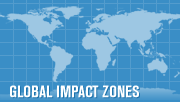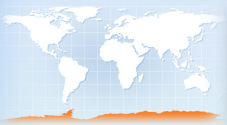Global warming threatens the world's largest ice cube

Antarctica has always been a land of surprises, dating back to its discovery and confirmation as a continent in the first half of the 1800s. But the impacts global warming is bringing to the world’s coldest continent are not welcome surprises.
Antarctica is covered by two ice sheets. The larger East Antarctic ice sheet covers the majority of the continent, while the West Antarctic ice sheet has significant ice shelves floating in the ocean. Taken together, they contain about 90 percent of Earth’s ice, 70 percent of its freshwater, and contain enough water to raise sea level by around 200 feet if they were to melt completely.
In the spring of 2002, scientists were shocked to discover that an ice shelf the size of Rhode Island had disintegrated in just over a month from the West Antarctica ice sheet. The collapse of the Larsen B ice shelf was a wake up call to scientists who had thought that these large areas of ice would take a millennium to disappear, not a month.
But the collapse of the Larsen B ice shelf was only the tip of the iceberg for ice loss in the Antarctic. Satellite measurements made by NASA since 2002 show that Antacrtica as a whole is losing mass at an accelerating rate.
Because the floating ice of the West Antarctic is subject to both warming air and ocean temperatures, scientists think it is especially vulnerable to global warming. Until recently, it was thought that only coastal areas of the West Antarctic were vulnerable to melting. But satellite analysis has revealed that large inland regions are also showing signs of the impacts of warming. There is also evidence that in addition to the loss known to be occurring in West Antarctica, East Antarctica has also been losing ice since 2006.
Human activities have been identified as an important driver of Antarctic climate change, though a complex set of natural factors are also important. Rigorous analysis of temperature trends show that Antarctica has been warming at an average rate of about 0.2 °F per decade (from 1957 to 2006) or about 1°F for the last half century, roughly comparable to the warming observed for the globe as a whole. Arctic warming is expected to continue as greenhouse gas concentrations rise and the ozone hole heals.
Ice isn’t the only thing on the decline in Antarctica. As ice extent shrinks, breeding and foraging habitat for Antarctic wildlife is compromised. The population of Emporer penguins has already declined by 50 percent. Researchers studying Emporer penguins in Terre Adélie, Antarctica, estimate that by the end of the century their population will decline from 6,000 breeding pairs to an expected 400 breeding pairs under IPCC climate projections of business as usual emissions of greenhouse gases.



